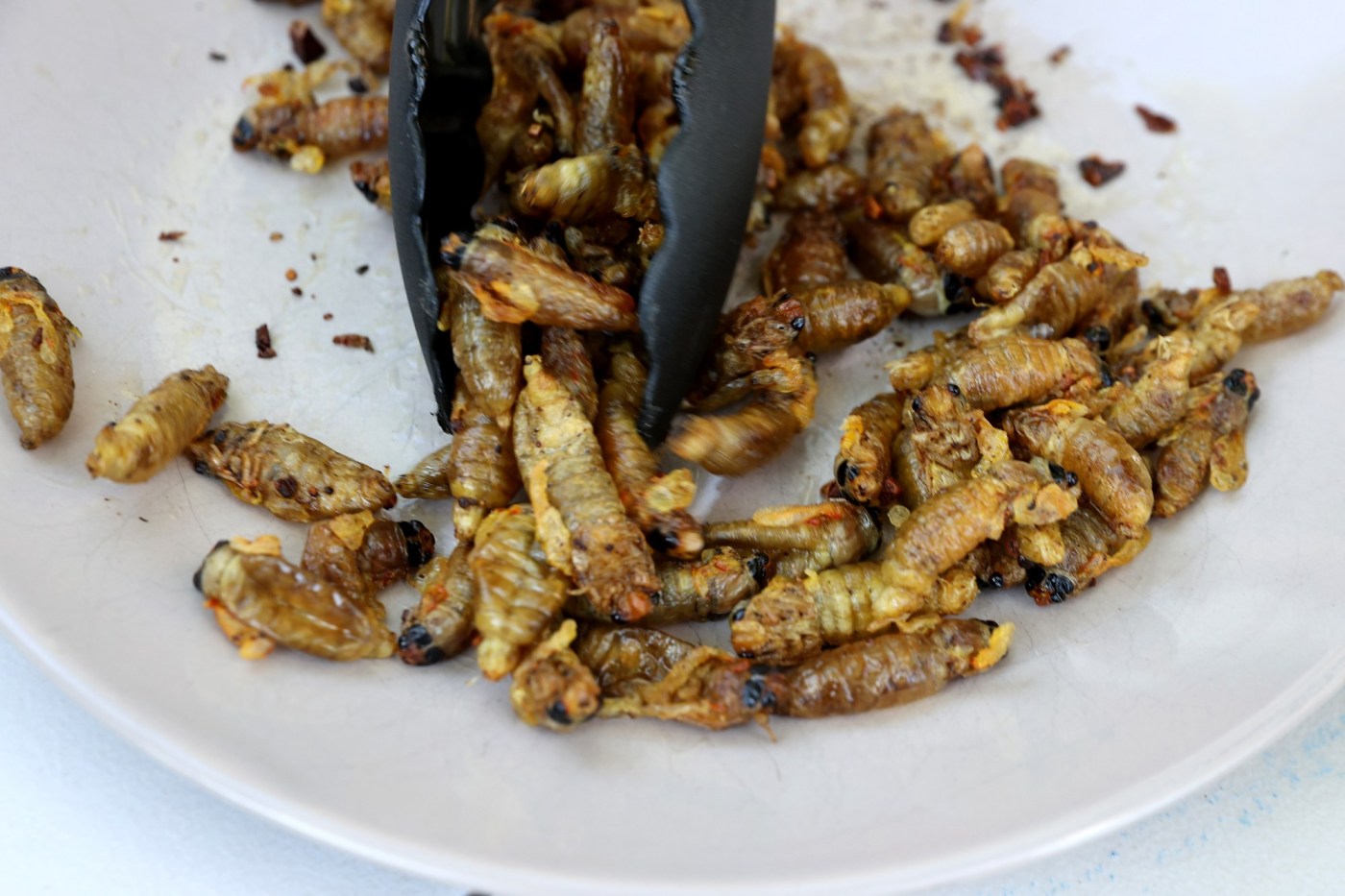
You may not be able to escape cicadas — but you can eat them
In early April, the No. 1 show on Netflix was “3 Body Problem,” about an alien invasion. The final image in the series is of swarming cicadas, and we can expect to see similar scenes all over Chicagoland in the coming months.
In 2007, we witnessed a sizable invasion of cicadas in Brood XIII. This spring, Brood XIII is coming back and will be joined by Brood XIX, a reunion that last ensued over two centuries ago. Illinois could host upward of a trillion cicadas. You cannot escape cicadas, but if it’s any consolation (and I understand if it isn’t), you can eat them.
Grossed out by the thought of eating bugs? Well, consider this: you’ve probably eaten pounds of them … in the past year!
“Insects or insect parts are found in most of the foods that we eat. The FDA has a Defect Levels Handbook that lists the allowable limits on ‘natural and unavoidable defects’ in commercial foods,” said Gina Hunter of Illinois State University and author of “Edible Insects: A Global History.” “For instance, peanut butter is limited to 30 insect fragments for 100 grams. Thus, it’s not surprising that the average American consumes an estimated 2 pounds of insects per year, as reported by the Centers for Invasive Species Research.”
So, it turns out, we’re all entomophages (bug eaters).
During the last infestation, I’d go cicada-hunting in the cool of the morning, when young cicadas (known as nymphs) emerge from their yearslong slumber with one thing in mind: mating. The cicada’s life is played out in three movements: emergence, mating and death. I prefer to snare them just as they’re emerging from the ground. Then they’re cleaned and cooked in boiling water before being stored in the refrigerator.
My wife and I whipped up tempura cicada nori rolls, which were rather pleasant. We dipped the boiled bugs in batter, fried them and lined them up lengthwise in a seaweed-rice roll with green onion, wasabi, lightly steamed carrot and soy sauce. To pair, our recommendation is a cup of sake.
There are many sustainable ecological advantages to eating insects instead of poultry, pork or beef: insects need much less space and water than chickens, pigs or cows, and they produce much less greenhouse gas.
“Many people have suggested that insects are a sustainable protein alternative to conventional meat sources (and) many food companies are investing in insect production,” Hunter said. “It’s mostly for animal feed right now; the market for insects in human food is very small. I do think we will see more insect-based foods in the future, most likely as an ingredient in processed foods.”
Andrew Moore, of Warrenville, tastes battered and fried cicadas that his dad, Kirk, on May 25, 2007. (Antonio Perez/Chicago Tribune)
Though she has found that insects have been a historically important foodstuff in China, Thailand and Australia, Hunter said that in the Western hemisphere, Mexico is undoubtedly the epicenter of insect cuisine. You’ll find bags of spicy Mexican grasshoppers in some Hispanic grocery stores.
I’ve had tacos filled with chapulines (little grasshoppers) in Oaxaca, Mexico, and at some local Mexican restaurants, such as Uptown’s Kie-Gol-Lanee, you can order fried chapulines as a starter. Frying makes many insects crunchy, which is nice, but I must admit it’s difficult to discern flavor in unadorned bugs. In Oaxaca, chapulines are seasoned with spices such as chili, garlic and lime. Spiced up, they’re tasty, but that taste seems to come mostly from what’s added to the grasshoppers.
Cicadas harvested in their teneral stage are pan-fried on June 4, 2021, in Hyattsville, Maryland. (Chip Somodevilla/Getty)
Are any bugs delicious without tasty condiments? “Yes,” Hunter said. “Insects get a lot of flavor from pheromones, which are on the outside of the body. Traditionally people might have eaten insects just straight up.”
Indeed, in the Australian outback, Aboriginal people and others eat witchetty grubs (moth larvae) right off the tree, no cooking, no condiments. We’ve heard they taste like scrambled eggs.
Do some insects taste better than others? “Yes!” Hunter said with enthusiasm. “Some ants have this bright, citrusy flavor that’s delicious.”
Kirk Moore, of Warrenville, prepares cicadas on May 25, 2007. (Antonio Perez/Chicago Tribune)
Insect cuisine is something “we should encourage,” said Maureen Turcatel, collection manager of insects at Chicago’s Field Museum of Natural History. Eating insects, she tells us, is “a very easy way to get a good source of protein” that doesn’t require a lot of resources.
If you’d like to enjoy exotic insects in the comfort of your home, Amazon offers a vast array of insect-based snacks such as salted black ants, dehydrated zebra tarantulas and bags of “mixed bugs” including mole crickets and silkworms. Or you can go into the Midwestern wilds to fetch bags full of cicadas. Turcatel explains that “when the soil gets warm, that’s a good indication that cicadas will emerge.” With the exceptionally mild winter and spring we’ve had, cicadas may emerge sooner than usual.
Caution: Cicadas are arthropods and belong to the same phylum as shrimp, lobsters and crabs. If you have a crustacean allergy, you might have an allergic reaction to eating cicadas. Also, it’s best to harvest cicadas in wooded areas, such as a forest preserve, rather than on local lawns, which may have been sprayed with insecticides and fertilizers.
Before the day comes when you can order a bug burger at a fast-casual restaurant, consider sampling what could be the hyper-local food of the future, soon to be crawling up a tree near you.
A Brood XIII cicada waits for its wings and new exoskeleton to dry and harden after climbing and molting on a tree in a front yard in Homewood on May 22, 2007. (E. Jason Wambsgans/Chicago Tribune)
How to tempura fry cicadas
In a plastic bag, collect 1 cup (or more) of cicada nymphs as they emerge from the ground
Drop cicadas in boiling water and boil for a minute or so
Remove cicadas and place on paper towels to dry
Blend ½ cup cornstarch, 2 tablespoons flour, ¼ teaspoon baking powder. Stir in one beaten egg and 2 tablespoons water; mix thoroughly
Dip each cicada in batter
Drop a handful of cicadas into 1 or 2 cups of hot vegetable oil and fry for about 30 seconds; repeat with other cicadas
Drain cicadas, then sprinkle with salt and pepper (or hot sauce!). Enjoy!
David Hammond is a freelance writer.
Would you like a cicada salad? The monstrous little noisemakers descend on a New Orleans menu
Illinois will soon be cicada central when 2 broods converge on state in historic emergence


